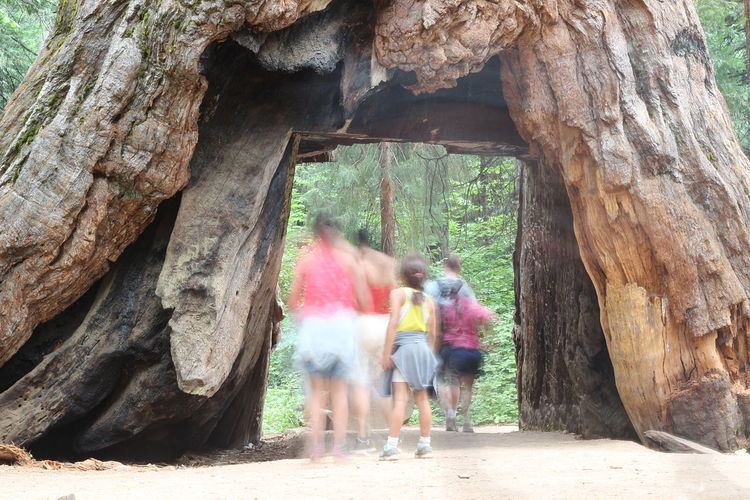Phone +1 209-795-2334 | Area 6,498 acres (26.30 km) Established 1931 | |
 | ||
Governing body California Department of Parks and Recreation Address 1170 CA-4, Arnold, CA 95223, USA Hours Open today · 7AM–5PMMonday7AM–5PMTuesday7AM–5PMWednesday7AM–5PMThursday7AM–5PMFriday7AM–5PMSaturday7AM–5PMSunday7AM–5PM Management California Department of Parks and Recreation Similar Sierra Nevada, Columbia State Historic P, Grover Hot Springs State Park, Sequoia National Park, Yosemite National Park | ||
Calaveras big trees state park
Calaveras Big Trees State Park is a state park of California, United States, preserving two groves of giant sequoia trees. It is located 4 miles (6.4 km) northeast of Arnold, California in the middle elevations of the Sierra Nevada. It has been a major tourist attraction since 1852, when the existence of the trees was first widely reported, and is considered the longest continuously operated tourist facility in California.
Contents
- Calaveras big trees state park
- Calaveras big trees state park california tour
- HistoryEdit
- Pioneer Cabin TreeEdit
- ActivitiesEdit
- References
Calaveras big trees state park california tour
HistoryEdit
The area was declared a state park in 1931 and now encompasses 6,498 acres (2,630 ha) in Calaveras and Tuolumne counties.
Over the years other parcels of mixed conifer forests, including the much larger South Calaveras Grove of Giant Sequoias(purchased in 1954 for US $2.8 million, equivalent to US $25 million in 2017 dollars), have been added to the park to bring the total area to over 6,400 acres (2,600 ha). The North Grove contains about 100 mature giant sequoias; the South Grove, about 1,000. According to Naturalist John Muir the forest protected by the park is: "A flowering glade in the very heart of the woods, forming a fine center for the student, and a delicious resting place for the weary."
The North Grove included the "Discovery Tree", noted by Augustus T. Dowd in 1852 and felled in 1853, leaving a giant stump, the only remainder of the tree. It measured 25 feet in diameter at its base and was determined by ring count to be 1,244 years old when felled. At the time the grove was discovered by white explorers, the Discovery Tree was measured by Dowd and others as the largest tree, and it was cut down to advertise the tourist attraction. Today only a fire-blackened snag remains of the Mother of the Forest, and the Discovery Tree has been renamed the Big Stump; the largest tree in the North Grove today is the Empire State tree, which measures 30 feet at ground level and 23 feet at 6 feet above ground.
In addition to the popular North Grove, the park also now includes the South Grove, with a 5-mile (8.0 km) hiking trip into a grove of giant sequoias in their natural setting. The South Grove includes the Louis Agassiz tree, 250 feet (76 m) tall and more than 25 feet (7.6 m) in diameter 6 feet (1.8 m) above ground, the largest tree in the Calaveras groves. It is named after zoologist Louis Agassiz (1807–1873).
Other attractions in the Park include the Stanislaus River, Beaver Creek, the Lava Bluff Trail, and Bradley Trail.
The park houses two main campgrounds with a total of 129 campsites, six picnic areas and hundreds of miles of established trails.
Pioneer Cabin TreeEdit
The iconic "Pioneer Cabin Tree", also known as "The Tunnel Tree", fell in 2017. Measuring 33 feet (10 m) in diameter, its exact age and height were not known. In the 1880s, the tree was hollowed out by a private land owner so that tourists could pass through it; the tree was chosen in part because it bore a large forest fire scar. The tree was estimated to be over one thousand years old. Some speculated that the hole bored through it was a causal factor in its demise. It was one of several drive-through trees in northern California.
ActivitiesEdit
Other activities include cross-country skiing, evening ranger talks, numerous interpretive programs, environmental educational programs, junior ranger programs, hiking, mountain biking, bird watching and summer school activities for school children. Dogs are welcome in the park on leash in developed areas like picnic sites, campgrounds, roads and fire roads (dirt). Dogs are not allowed on the designated trails, nor in the woods in general.
